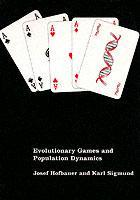Description
Evolutionary Games and Population Dynamics
Authors: Hofbauer Josef, Sigmund Karl
How to understand evolution in mathematical terms, i.e. how to model natural selection by game theory.
Language: English
Subject for Evolutionary Games and Population Dynamics:
Approximative price 73.88 €
Subject to availability at the publisher.
Add to cart
Publication date: 05-1998
352 p. · 18.9x24.6 cm · Paperback
352 p. · 18.9x24.6 cm · Paperback
Description
/li>Contents
/li>Comment
/li>
Every form of behaviour is shaped by trial and error. Such stepwise adaptation can occur through individual learning or through natural selection, the basis of evolution. Since the work of Maynard Smith and others, it has been realised how game theory can model this process. Evolutionary game theory replaces the static solutions of classical game theory by a dynamical approach centred not on the concept of rational players but on the population dynamics of behavioural programmes. In this book the authors investigate the nonlinear dynamics of the self-regulation of social and economic behaviour, and of the closely related interactions between species in ecological communities. Replicator equations describe how successful strategies spread and thereby create new conditions which can alter the basis of their success, i.e. to enable us to understand the strategic and genetic foundations of the endless chronicle of invasions and extinctions which punctuate evolution. In short, evolutionary game theory describes when to escalate a conflict, how to elicit cooperation, why to expect a balance of the sexes, and how to understand natural selection in mathematical terms.
Introduction for game theorists; Introduction for biologists; Part I. Dynamical Systems And Lotka-Volterra Equations: 1. The logistic equation; 2. Lotka-Volterra for predator-prey systems; 3. Lotka-Volterra for two competitors; 4. Ecological equations for two species; 5. Lotka-Volterra for more than two populations; Part II. Game Dynamics And Replicator Equations: 6. Evolutionarily stable strategies; 7. Replicator equations; 8. Other game dynamics; 9. Adaptive dynamics; 10. Asymmetric conflicts; 11. More on bimatrix games; Part III. More On Lotka-Volterra And Replicator Dynamics: 12. Hypercircles and permanence; 13. Criteria for permanence; 14. Replicator networks; 15. Stability in n-species communities; 16. Some low-dimensional ecological systems; 17. Heteroclinic cycles and C-matrices; Part IV. Population Genetics: 18. Discrete dynamical systems in population genetics; 19. Continuous selection dynamics; 20. Mutation and recombination; 21. Fertility selection; 22. Game dynamics for Mendelian populations; Bibliography; Index.
Since the work of Maynard Smith and others, it has been realised how game theory can model natural selection. Evolutionary game theory replaces the concept of rational players with the population dynamics of behavioural programs and can be used to understand the strategic and genetic foundations of the endless chronicle of invasions and extinctions which punctuate evolution. In short, it describes when to escalate a conflict, how to elicit cooperation, why to expect a balance of the sexes, and how to understand natural selection in mathematical terms.
© 2024 LAVOISIER S.A.S.

